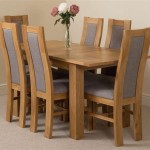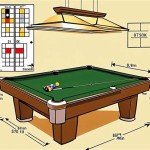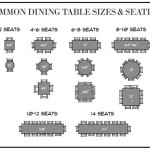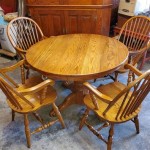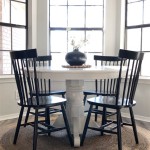```html
Rectangle Rug With Round Table: A Design Guide
The combination of a rectangle rug under a round table presents both a design challenge and an opportunity. Successfully integrating these two shapes can create visually appealing and functional spaces within a home. This article explores the considerations, strategies, and potential pitfalls of pairing a rectangle rug with a round table, offering guidance on achieving a harmonious balance in interior design.
Understanding the Geometric Relationship
The primary design consideration is the inherent contrast between the rectangle and the circle. A rectangle, with its defined edges and corners, offers a sense of structure and linearity. Conversely, a circle, represented by the round table, introduces softness, curvature, and visual flow. When these two shapes interact, the goal is to leverage their differences to create a balanced and visually interesting arrangement. Simply placing a round table haphazardly on a rectangle rug can lead to a disjointed and unbalanced aesthetic. Careful planning and execution are essential to ensure a cohesive design.
One approach is to consider the scale of both the rug and the table. A proportionally smaller rug can make the table appear oversized and overwhelming. Conversely, a rug that is too large can diminish the visual impact of the table. The ideal scenario is to select a rug size that comfortably accommodates the table and allows for adequate space around it, ensuring that chairs can be pulled out without extending beyond the rug's boundaries. The rug should act as a visual anchor, defining the seating area centered around the round table.
Another geometric factor involves the placement of the round table on the rectangle rug. Centering the table on the rug is often the most straightforward and symmetrical solution. However, depending on the room's layout and the intended function of the space, an off-center placement might be more appropriate. For instance, if the table is positioned near a wall, shifting it slightly towards the center of the rug can create a more balanced visual effect. Experimentation with different placements is encouraged to determine the most aesthetically pleasing arrangement.
Key Considerations for Rug Size and Placement
Determining the appropriate size of the rectangle rug is crucial for achieving visual harmony. A common guideline is to ensure that all legs of the chairs surrounding the round table remain on the rug, even when pulled out. Failing to adhere to this principle can result in an unstable and visually fragmented space. Measure the diameter of the table and add approximately 24 to 36 inches on each side to determine the minimum rug size. This allows for ample space for chair movement and prevents the rug from appearing undersized.
The placement of the rectangle rug relative to the surrounding furniture and architectural elements is equally important. Align the rug with other prominent features in the room, such as walls, doorways, or existing furniture groupings. Creating a visual connection between the rug and other elements helps to unify the space and establish a sense of order. Avoid placing the rug at an awkward angle or in a way that disrupts the flow of traffic through the room. Consider the room's shape and dimensions when positioning the rug to maximize its aesthetic impact.
In open-concept living spaces, a rectangle rug can serve to define a specific zone dedicated to the round table and its seating area. The rug acts as a visual boundary, separating the dining or conversation area from other functions within the larger space. This is particularly useful in rooms where multiple activities occur simultaneously, helping to create a sense of organization and purpose. The rug's color and pattern can further reinforce this separation, contributing to a cohesive and well-defined interior design.
Choosing the Right Style and Material
The style and material of the rectangle rug should complement both the round table and the overall aesthetic of the room. Consider the existing décor, including the color palette, furniture styles, and architectural details. Selecting a rug that harmonizes with these elements is essential for creating a cohesive and visually appealing space. A rug that clashes with the surrounding décor can detract from the overall design and create a sense of disharmony.
For a more formal setting, consider a rug made from luxurious materials such as wool or silk. These materials offer a soft texture, rich colors, and a sophisticated appearance. Persian or Oriental rugs, with their intricate patterns and traditional motifs, can add a touch of elegance and refinement to the space. Ensure that the rug's pattern does not compete with the round table's design, but rather complements it.
In more casual settings, consider rugs made from more durable and practical materials such as jute, sisal, or synthetic fibers. These materials are resistant to stains, easy to clean, and suitable for high-traffic areas. Their natural textures and neutral colors can create a relaxed and inviting atmosphere. A simple, geometric pattern or a solid color can provide a subtle backdrop for the round table, allowing it to take center stage.
The color of the rectangle rug plays a significant role in the overall aesthetic. A rug in a neutral color palette, such as beige, gray, or ivory, can create a calming and understated backdrop, allowing the round table and its surrounding chairs to command attention. A rug in a bolder color, such as navy, emerald green, or ruby red, can add a pop of energy and visual interest to the space. Carefully consider the existing color scheme of the room and choose a rug color that complements and enhances the overall design. A contrasting color can create a focal point, while a complementary color can create a sense of harmony.
The texture of the rectangle rug is also an important consideration. A high-pile rug can add warmth and comfort to the space, while a low-pile rug can create a more sleek and contemporary look. Consider the function of the room and choose a rug texture that is both aesthetically pleasing and practical. In a dining area, a low-pile rug is often preferable as it is easier to clean and less likely to snag on chair legs. In a living room, a high-pile rug can create a cozy and inviting atmosphere.
Ultimately, the choice of style and material for the rectangle rug is a personal one, influenced by individual preferences and the specific characteristics of the space. Experiment with different options and consider seeking advice from an interior design professional to ensure a successful outcome.
Addressing Common Design Challenges
One common challenge when pairing a rectangle rug with a round table is the potential for the rug to appear too dominant or to create an awkward visual imbalance. This can occur if the rug is too large, too brightly colored, or has a pattern that clashes with the table or the surrounding décor. To mitigate this issue, carefully consider the rug's size, color, and pattern, ensuring that it complements rather than overwhelms the space.
Another challenge arises when the round table is positioned near a corner or wall. In such cases, the rectangle rug may appear misaligned or out of place. To address this, consider angling the rug slightly to align with the table or the surrounding walls. This can create a more balanced and visually appealing arrangement. Alternatively, use the rug to define a broader area that encompasses the table and other nearby furniture, creating a cohesive and well-defined zone.
Uneven flooring or architectural irregularities can also pose a design challenge. If the floor is not perfectly level, the rectangle rug may not lie flat, creating a tripping hazard or an unsightly appearance. To remedy this, consider using a rug pad or underlayment to provide cushioning and stability. If there are architectural irregularities, such as a protruding wall or an awkwardly placed doorway, adapt the rug's placement to accommodate these features, creating a sense of visual harmony rather than attempting to force a symmetrical arrangement.
Finally, maintaining the cleanliness and appearance of the rectangle rug is essential for preserving its aesthetic appeal. Regularly vacuum the rug to remove dirt and debris, and promptly address any spills or stains. Consider using a professional rug cleaning service periodically to deep clean the rug and maintain its original luster. Proper care and maintenance will ensure that the rectangle rug continues to enhance the space for years to come.
```
Rules Of Thumb For Rugs Under Round Dining Tables Inspiration

Rules Of Thumb For Rugs Under Round Dining Tables Inspiration

Rules Of Thumb For Rugs Under Round Dining Tables Inspiration

How To Place A Rug With Round Dining Table

10 Tips For Getting A Dining Room Rug Just Right Esmaili Rugs

27 Rugs Under Round Tables To Add A Wow Factor In Your Dining Room

6 Rules For Choosing A Dining Room Rug Pretty Sources Stonegable

Round And Rectangular Rugs Which Shape Should You Pick

What Size Rug Under Dining Table Here S The Best Way To Find Righ

Rules Of Thumb For Rugs Under Round Dining Tables Inspiration



